ABC Financial: Report on Importance of Organizational Investment
VerifiedAdded on 2023/04/20
|24
|5407
|275
Report
AI Summary
This report, prepared for ABC Financial, Inc., examines the importance of organizational investment in job training to improve employee performance. It uses primary research, including employee surveys, and secondary research to analyze current training programs and identify areas for improvement. The findings indicate that employees experience job dissatisfaction, lack of motivation, a lack of job-specific skills, and poor attitudes, all contributing to substandard performance. The report highlights the need for online training solutions, employee involvement in program creation, and regular training program reviews. It also addresses factors beyond training, such as mean-spirited managers, that affect job satisfaction. The report concludes with recommendations for implementing a new online training program, conducting annual reviews, and evaluating program effectiveness, emphasizing that proper job training leads to higher job satisfaction, enhanced productivity, and a competitive advantage. The estimated implementation cost for the new program is $10,000, with yearly maintenance fees ranging from $500 to $1,000. Desklib provides access to similar solved assignments and study resources for students.

March 17, 2019
Mr. Matthew J. Kogan
Executive Management
ABC Financial, Inc.
1631 Front Street
Wilmington, DE 19805
Dear Mr. Kogan:
Enclosed is the report on “Importance of Organizational Investment in Job Training,”
compiled per your request following the proposal memo I submitted two weeks ago.
This report provides an analysisof employee performance throughout the organization and
seeks to determine how current employee weaknesses can be strengthened through
ongoingonline training. The training procedures in place have beenscrutinized to determine
employee attitudes towards them and establish the necessary changes that must be made to
optimize job training.
Thank you for taking the time toreview this report, and I hope the findings will prove useful
as the organization makes job training decisions in the future.
Sincerely,
(Signature)
Jessica M. Mauck
Portfolio Administrator
Mr. Matthew J. Kogan
Executive Management
ABC Financial, Inc.
1631 Front Street
Wilmington, DE 19805
Dear Mr. Kogan:
Enclosed is the report on “Importance of Organizational Investment in Job Training,”
compiled per your request following the proposal memo I submitted two weeks ago.
This report provides an analysisof employee performance throughout the organization and
seeks to determine how current employee weaknesses can be strengthened through
ongoingonline training. The training procedures in place have beenscrutinized to determine
employee attitudes towards them and establish the necessary changes that must be made to
optimize job training.
Thank you for taking the time toreview this report, and I hope the findings will prove useful
as the organization makes job training decisions in the future.
Sincerely,
(Signature)
Jessica M. Mauck
Portfolio Administrator
Paraphrase This Document
Need a fresh take? Get an instant paraphrase of this document with our AI Paraphraser
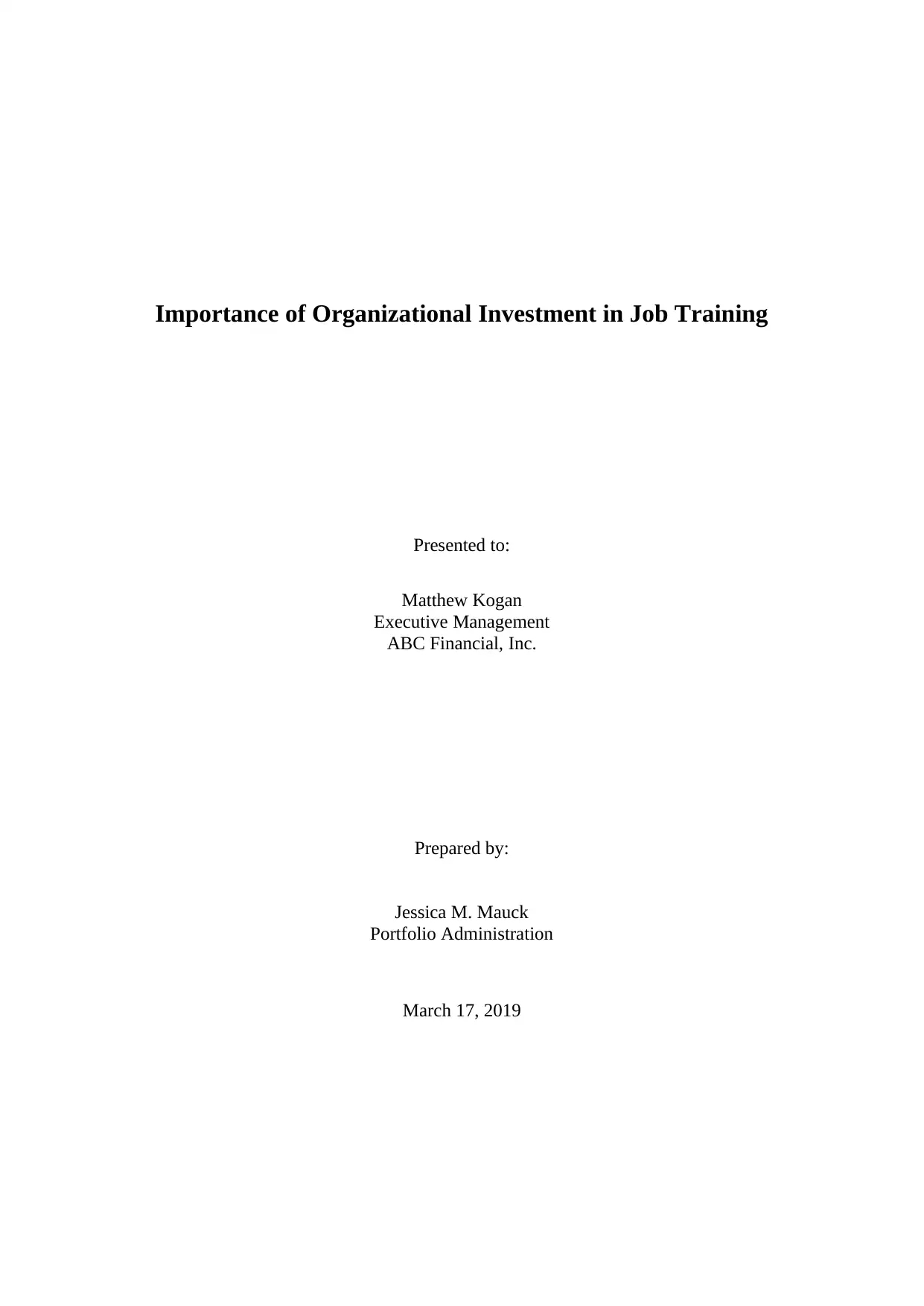
Importance of Organizational Investment in Job Training
Presented to:
Matthew Kogan
Executive Management
ABC Financial, Inc.
Prepared by:
Jessica M. Mauck
Portfolio Administration
March 17, 2019
Presented to:
Matthew Kogan
Executive Management
ABC Financial, Inc.
Prepared by:
Jessica M. Mauck
Portfolio Administration
March 17, 2019
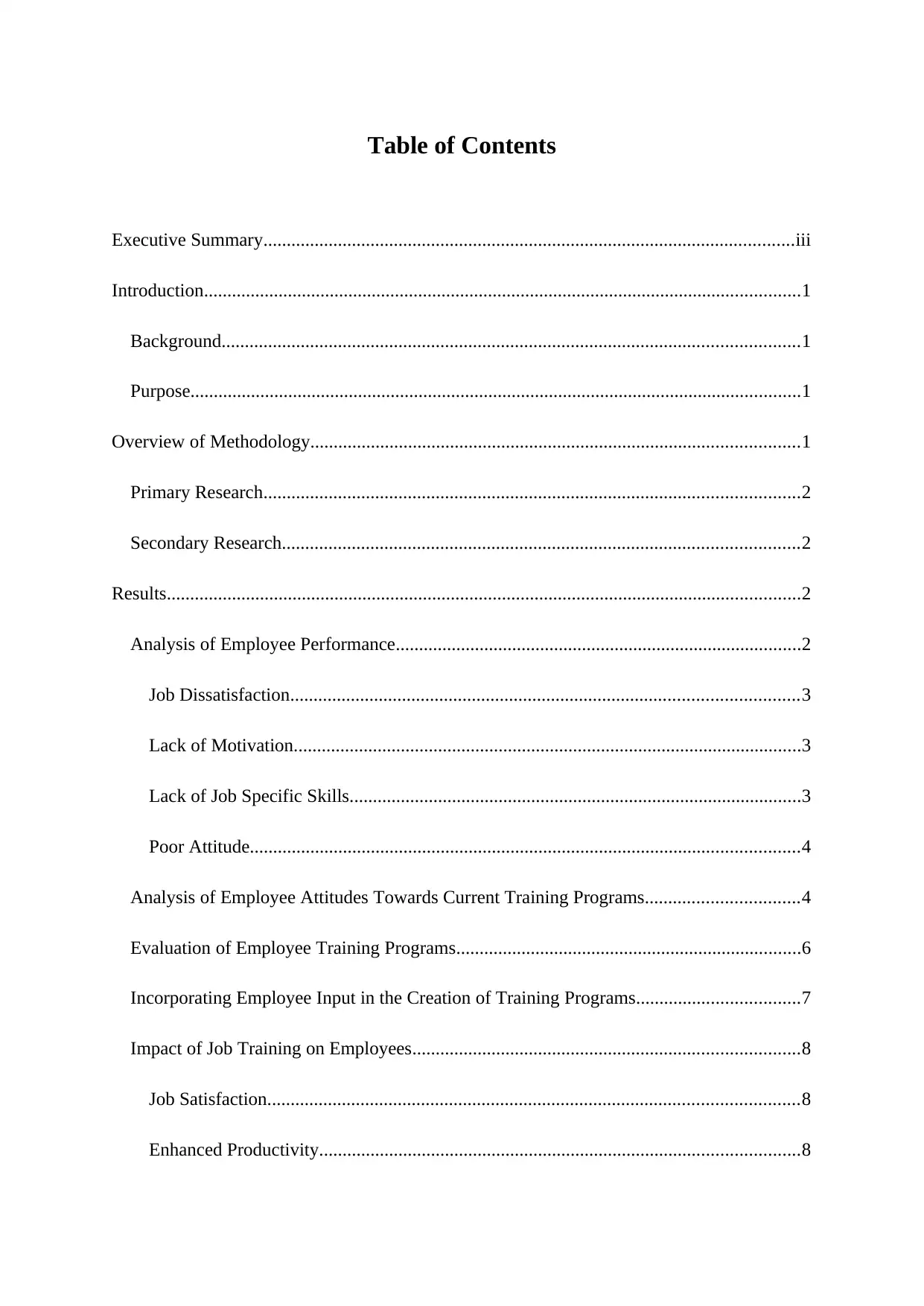
Table of Contents
Executive Summary..................................................................................................................iii
Introduction................................................................................................................................1
Background............................................................................................................................1
Purpose...................................................................................................................................1
Overview of Methodology.........................................................................................................1
Primary Research...................................................................................................................2
Secondary Research...............................................................................................................2
Results........................................................................................................................................2
Analysis of Employee Performance.......................................................................................2
Job Dissatisfaction.............................................................................................................3
Lack of Motivation.............................................................................................................3
Lack of Job Specific Skills.................................................................................................3
Poor Attitude......................................................................................................................4
Analysis of Employee Attitudes Towards Current Training Programs.................................4
Evaluation of Employee Training Programs..........................................................................6
Incorporating Employee Input in the Creation of Training Programs...................................7
Impact of Job Training on Employees...................................................................................8
Job Satisfaction..................................................................................................................8
Enhanced Productivity.......................................................................................................8
Executive Summary..................................................................................................................iii
Introduction................................................................................................................................1
Background............................................................................................................................1
Purpose...................................................................................................................................1
Overview of Methodology.........................................................................................................1
Primary Research...................................................................................................................2
Secondary Research...............................................................................................................2
Results........................................................................................................................................2
Analysis of Employee Performance.......................................................................................2
Job Dissatisfaction.............................................................................................................3
Lack of Motivation.............................................................................................................3
Lack of Job Specific Skills.................................................................................................3
Poor Attitude......................................................................................................................4
Analysis of Employee Attitudes Towards Current Training Programs.................................4
Evaluation of Employee Training Programs..........................................................................6
Incorporating Employee Input in the Creation of Training Programs...................................7
Impact of Job Training on Employees...................................................................................8
Job Satisfaction..................................................................................................................8
Enhanced Productivity.......................................................................................................8
⊘ This is a preview!⊘
Do you want full access?
Subscribe today to unlock all pages.

Trusted by 1+ million students worldwide
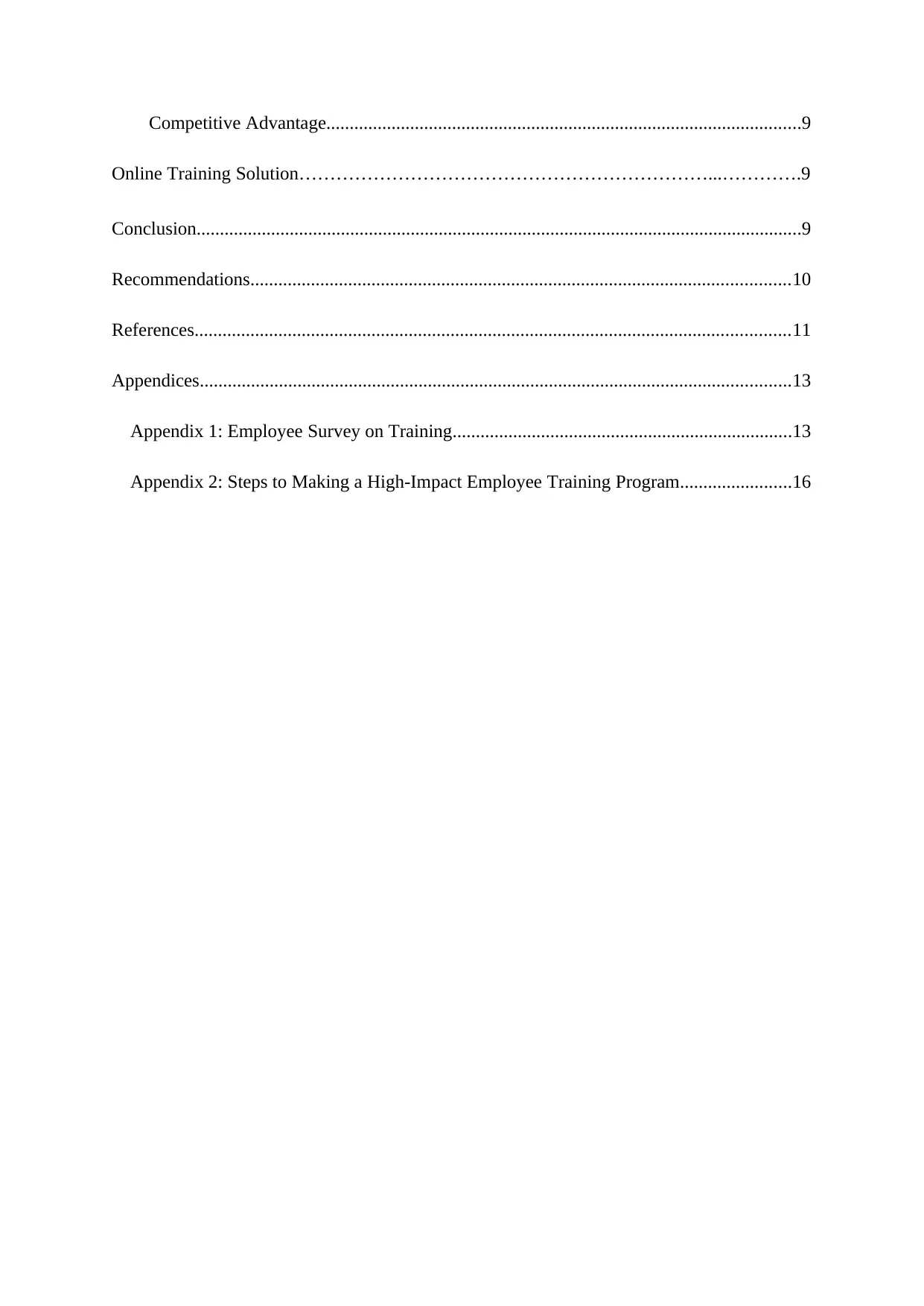
Competitive Advantage......................................................................................................9
Online Training Solution…………………………………………………………...………….9
Conclusion..................................................................................................................................9
Recommendations....................................................................................................................10
References................................................................................................................................11
Appendices...............................................................................................................................13
Appendix 1: Employee Survey on Training.........................................................................13
Appendix 2: Steps to Making a High-Impact Employee Training Program........................16
Online Training Solution…………………………………………………………...………….9
Conclusion..................................................................................................................................9
Recommendations....................................................................................................................10
References................................................................................................................................11
Appendices...............................................................................................................................13
Appendix 1: Employee Survey on Training.........................................................................13
Appendix 2: Steps to Making a High-Impact Employee Training Program........................16
Paraphrase This Document
Need a fresh take? Get an instant paraphrase of this document with our AI Paraphraser

Table of Figures
Figure 1:Responses to Survey Question 4 2
Figure 2:Responses to Survey Question 1 4
Figure 3:Responses to Survey Question 2 5
Figure 4:Responses to Survey Question 3 5
Figure 5:Responses to Survey Question 5 6
Figure 6:Responses to Survey Question 6 7
Figure 7:Responses to Survey Question 7 7
Figure 1:Responses to Survey Question 4 2
Figure 2:Responses to Survey Question 1 4
Figure 3:Responses to Survey Question 2 5
Figure 4:Responses to Survey Question 3 5
Figure 5:Responses to Survey Question 5 6
Figure 6:Responses to Survey Question 6 7
Figure 7:Responses to Survey Question 7 7
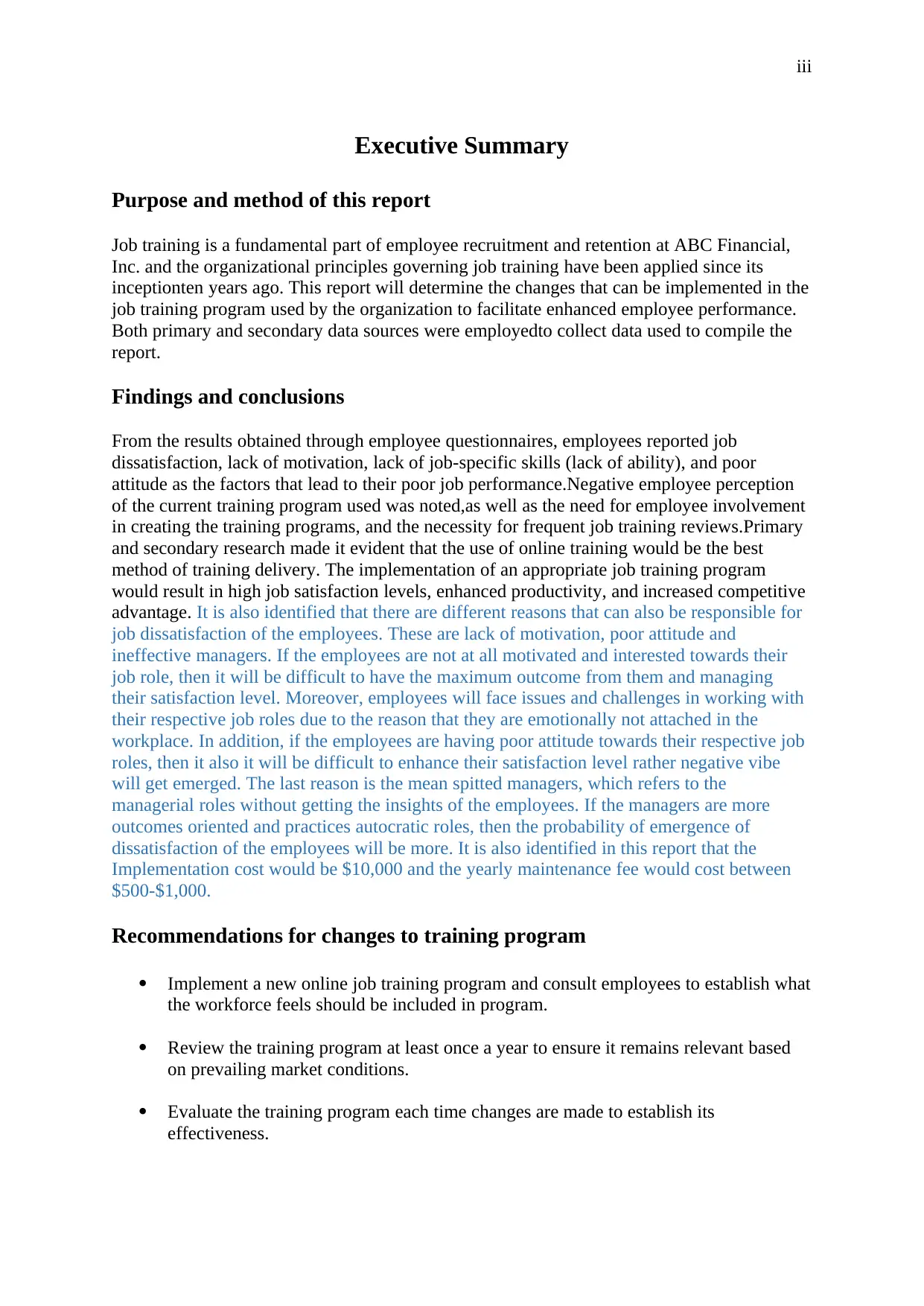
iii
Executive Summary
Purpose and method of this report
Job training is a fundamental part of employee recruitment and retention at ABC Financial,
Inc. and the organizational principles governing job training have been applied since its
inceptionten years ago. This report will determine the changes that can be implemented in the
job training program used by the organization to facilitate enhanced employee performance.
Both primary and secondary data sources were employedto collect data used to compile the
report.
Findings and conclusions
From the results obtained through employee questionnaires, employees reported job
dissatisfaction, lack of motivation, lack of job-specific skills (lack of ability), and poor
attitude as the factors that lead to their poor job performance.Negative employee perception
of the current training program used was noted,as well as the need for employee involvement
in creating the training programs, and the necessity for frequent job training reviews.Primary
and secondary research made it evident that the use of online training would be the best
method of training delivery. The implementation of an appropriate job training program
would result in high job satisfaction levels, enhanced productivity, and increased competitive
advantage. It is also identified that there are different reasons that can also be responsible for
job dissatisfaction of the employees. These are lack of motivation, poor attitude and
ineffective managers. If the employees are not at all motivated and interested towards their
job role, then it will be difficult to have the maximum outcome from them and managing
their satisfaction level. Moreover, employees will face issues and challenges in working with
their respective job roles due to the reason that they are emotionally not attached in the
workplace. In addition, if the employees are having poor attitude towards their respective job
roles, then it also it will be difficult to enhance their satisfaction level rather negative vibe
will get emerged. The last reason is the mean spitted managers, which refers to the
managerial roles without getting the insights of the employees. If the managers are more
outcomes oriented and practices autocratic roles, then the probability of emergence of
dissatisfaction of the employees will be more. It is also identified in this report that the
Implementation cost would be $10,000 and the yearly maintenance fee would cost between
$500-$1,000.
Recommendations for changes to training program
Implement a new online job training program and consult employees to establish what
the workforce feels should be included in program.
Review the training program at least once a year to ensure it remains relevant based
on prevailing market conditions.
Evaluate the training program each time changes are made to establish its
effectiveness.
Executive Summary
Purpose and method of this report
Job training is a fundamental part of employee recruitment and retention at ABC Financial,
Inc. and the organizational principles governing job training have been applied since its
inceptionten years ago. This report will determine the changes that can be implemented in the
job training program used by the organization to facilitate enhanced employee performance.
Both primary and secondary data sources were employedto collect data used to compile the
report.
Findings and conclusions
From the results obtained through employee questionnaires, employees reported job
dissatisfaction, lack of motivation, lack of job-specific skills (lack of ability), and poor
attitude as the factors that lead to their poor job performance.Negative employee perception
of the current training program used was noted,as well as the need for employee involvement
in creating the training programs, and the necessity for frequent job training reviews.Primary
and secondary research made it evident that the use of online training would be the best
method of training delivery. The implementation of an appropriate job training program
would result in high job satisfaction levels, enhanced productivity, and increased competitive
advantage. It is also identified that there are different reasons that can also be responsible for
job dissatisfaction of the employees. These are lack of motivation, poor attitude and
ineffective managers. If the employees are not at all motivated and interested towards their
job role, then it will be difficult to have the maximum outcome from them and managing
their satisfaction level. Moreover, employees will face issues and challenges in working with
their respective job roles due to the reason that they are emotionally not attached in the
workplace. In addition, if the employees are having poor attitude towards their respective job
roles, then it also it will be difficult to enhance their satisfaction level rather negative vibe
will get emerged. The last reason is the mean spitted managers, which refers to the
managerial roles without getting the insights of the employees. If the managers are more
outcomes oriented and practices autocratic roles, then the probability of emergence of
dissatisfaction of the employees will be more. It is also identified in this report that the
Implementation cost would be $10,000 and the yearly maintenance fee would cost between
$500-$1,000.
Recommendations for changes to training program
Implement a new online job training program and consult employees to establish what
the workforce feels should be included in program.
Review the training program at least once a year to ensure it remains relevant based
on prevailing market conditions.
Evaluate the training program each time changes are made to establish its
effectiveness.
⊘ This is a preview!⊘
Do you want full access?
Subscribe today to unlock all pages.

Trusted by 1+ million students worldwide

1
Introduction
Background
Job training is a fundamental part of employee recruitment and retention at ABC Financial,
Inc., and the organizational principles governing job traininghave been applied since its
launch ten years ago.Due to the dynamic nature of the financial services industry, a need for
the revision to the training principles has emerged andwill ensure that ABC Financials’
training program continues to meet the standardrequirements of employee training. Adequate
training isneeded for the organization to maintain its competitive advantage. The need for
changewas further emphasized in the last staff meeting when management suggestedthat the
organization should consider revising its training procedures in order to increase the ability to
retain employees, clients, and to expand its market niche.Management expressed concern
about stagnatedemployee performance despite the continued application of training methods
in the organization. This observation necessitated the need to review current training
programs and provided research backing the need for a change in the training program.
Organizations must invest as much as possible in employee training.
Purpose
This report will determine the changes that can be implemented in the job training program
used by ABC Financial to facilitate enhanced employee performance. It will also highlight
the necessity of continued investment in the enhancement of job training procedures
implemented within the organization and offer suggestions for optimization.
Overview of Methodology
Gathering data for the compilation of the report required that both primary and secondary
research methods be used. Secondary data provided evidence that reinforced the findings
obtained from primary data collection.
The data collection activities involved:
Collection of information on current training methods used through the
administration of an employee survey.
Introduction
Background
Job training is a fundamental part of employee recruitment and retention at ABC Financial,
Inc., and the organizational principles governing job traininghave been applied since its
launch ten years ago.Due to the dynamic nature of the financial services industry, a need for
the revision to the training principles has emerged andwill ensure that ABC Financials’
training program continues to meet the standardrequirements of employee training. Adequate
training isneeded for the organization to maintain its competitive advantage. The need for
changewas further emphasized in the last staff meeting when management suggestedthat the
organization should consider revising its training procedures in order to increase the ability to
retain employees, clients, and to expand its market niche.Management expressed concern
about stagnatedemployee performance despite the continued application of training methods
in the organization. This observation necessitated the need to review current training
programs and provided research backing the need for a change in the training program.
Organizations must invest as much as possible in employee training.
Purpose
This report will determine the changes that can be implemented in the job training program
used by ABC Financial to facilitate enhanced employee performance. It will also highlight
the necessity of continued investment in the enhancement of job training procedures
implemented within the organization and offer suggestions for optimization.
Overview of Methodology
Gathering data for the compilation of the report required that both primary and secondary
research methods be used. Secondary data provided evidence that reinforced the findings
obtained from primary data collection.
The data collection activities involved:
Collection of information on current training methods used through the
administration of an employee survey.
Paraphrase This Document
Need a fresh take? Get an instant paraphrase of this document with our AI Paraphraser
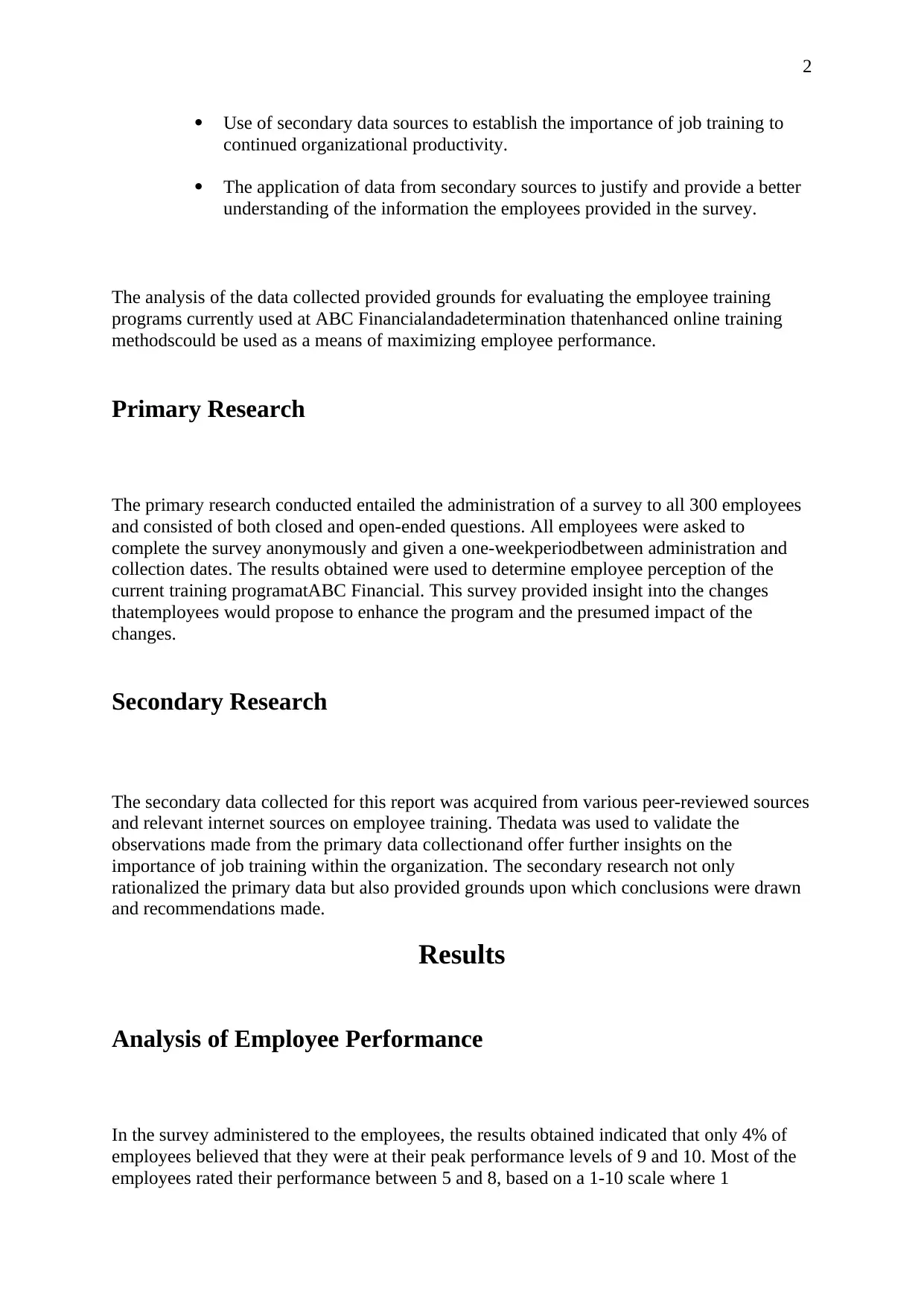
2
Use of secondary data sources to establish the importance of job training to
continued organizational productivity.
The application of data from secondary sources to justify and provide a better
understanding of the information the employees provided in the survey.
The analysis of the data collected provided grounds for evaluating the employee training
programs currently used at ABC Financialandadetermination thatenhanced online training
methodscould be used as a means of maximizing employee performance.
Primary Research
The primary research conducted entailed the administration of a survey to all 300 employees
and consisted of both closed and open-ended questions. All employees were asked to
complete the survey anonymously and given a one-weekperiodbetween administration and
collection dates. The results obtained were used to determine employee perception of the
current training programatABC Financial. This survey provided insight into the changes
thatemployees would propose to enhance the program and the presumed impact of the
changes.
Secondary Research
The secondary data collected for this report was acquired from various peer-reviewed sources
and relevant internet sources on employee training. Thedata was used to validate the
observations made from the primary data collectionand offer further insights on the
importance of job training within the organization. The secondary research not only
rationalized the primary data but also provided grounds upon which conclusions were drawn
and recommendations made.
Results
Analysis of Employee Performance
In the survey administered to the employees, the results obtained indicated that only 4% of
employees believed that they were at their peak performance levels of 9 and 10. Most of the
employees rated their performance between 5 and 8, based on a 1-10 scale where 1
Use of secondary data sources to establish the importance of job training to
continued organizational productivity.
The application of data from secondary sources to justify and provide a better
understanding of the information the employees provided in the survey.
The analysis of the data collected provided grounds for evaluating the employee training
programs currently used at ABC Financialandadetermination thatenhanced online training
methodscould be used as a means of maximizing employee performance.
Primary Research
The primary research conducted entailed the administration of a survey to all 300 employees
and consisted of both closed and open-ended questions. All employees were asked to
complete the survey anonymously and given a one-weekperiodbetween administration and
collection dates. The results obtained were used to determine employee perception of the
current training programatABC Financial. This survey provided insight into the changes
thatemployees would propose to enhance the program and the presumed impact of the
changes.
Secondary Research
The secondary data collected for this report was acquired from various peer-reviewed sources
and relevant internet sources on employee training. Thedata was used to validate the
observations made from the primary data collectionand offer further insights on the
importance of job training within the organization. The secondary research not only
rationalized the primary data but also provided grounds upon which conclusions were drawn
and recommendations made.
Results
Analysis of Employee Performance
In the survey administered to the employees, the results obtained indicated that only 4% of
employees believed that they were at their peak performance levels of 9 and 10. Most of the
employees rated their performance between 5 and 8, based on a 1-10 scale where 1
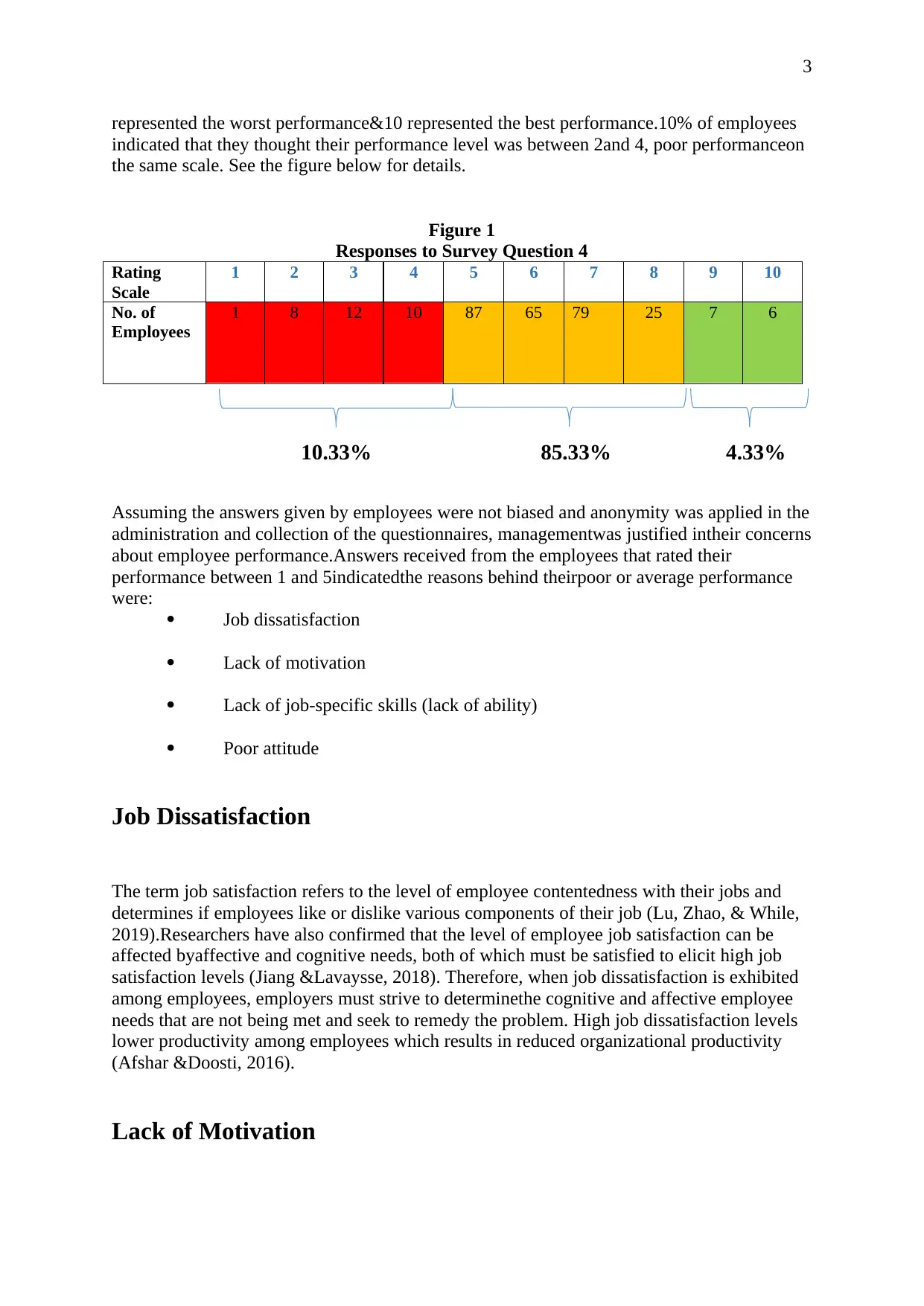
3
represented the worst performance&10 represented the best performance.10% of employees
indicated that they thought their performance level was between 2and 4, poor performanceon
the same scale. See the figure below for details.
Figure 1
Responses to Survey Question 4
Rating
Scale
1 2 3 4 5 6 7 8 9 10
No. of
Employees
1 8 12 10 87 65 79 25 7 6
10.33% 85.33% 4.33%
Assuming the answers given by employees were not biased and anonymity was applied in the
administration and collection of the questionnaires, managementwas justified intheir concerns
about employee performance.Answers received from the employees that rated their
performance between 1 and 5indicatedthe reasons behind theirpoor or average performance
were:
Job dissatisfaction
Lack of motivation
Lack of job-specific skills (lack of ability)
Poor attitude
Job Dissatisfaction
The term job satisfaction refers to the level of employee contentedness with their jobs and
determines if employees like or dislike various components of their job (Lu, Zhao, & While,
2019).Researchers have also confirmed that the level of employee job satisfaction can be
affected byaffective and cognitive needs, both of which must be satisfied to elicit high job
satisfaction levels (Jiang &Lavaysse, 2018). Therefore, when job dissatisfaction is exhibited
among employees, employers must strive to determinethe cognitive and affective employee
needs that are not being met and seek to remedy the problem. High job dissatisfaction levels
lower productivity among employees which results in reduced organizational productivity
(Afshar &Doosti, 2016).
Lack of Motivation
represented the worst performance&10 represented the best performance.10% of employees
indicated that they thought their performance level was between 2and 4, poor performanceon
the same scale. See the figure below for details.
Figure 1
Responses to Survey Question 4
Rating
Scale
1 2 3 4 5 6 7 8 9 10
No. of
Employees
1 8 12 10 87 65 79 25 7 6
10.33% 85.33% 4.33%
Assuming the answers given by employees were not biased and anonymity was applied in the
administration and collection of the questionnaires, managementwas justified intheir concerns
about employee performance.Answers received from the employees that rated their
performance between 1 and 5indicatedthe reasons behind theirpoor or average performance
were:
Job dissatisfaction
Lack of motivation
Lack of job-specific skills (lack of ability)
Poor attitude
Job Dissatisfaction
The term job satisfaction refers to the level of employee contentedness with their jobs and
determines if employees like or dislike various components of their job (Lu, Zhao, & While,
2019).Researchers have also confirmed that the level of employee job satisfaction can be
affected byaffective and cognitive needs, both of which must be satisfied to elicit high job
satisfaction levels (Jiang &Lavaysse, 2018). Therefore, when job dissatisfaction is exhibited
among employees, employers must strive to determinethe cognitive and affective employee
needs that are not being met and seek to remedy the problem. High job dissatisfaction levels
lower productivity among employees which results in reduced organizational productivity
(Afshar &Doosti, 2016).
Lack of Motivation
⊘ This is a preview!⊘
Do you want full access?
Subscribe today to unlock all pages.

Trusted by 1+ million students worldwide

4
Employee motivation is critical to organizational performance because it is directly and
proportionally related to the productivity levels of the employees and the organization
(Lazaroiu, 2015).Employers must motivate their employees if they seek to maintain high
productivity levels within their organizations (Lazaroiu, 2015). The lack of motivation among
employees results in stagnated employee development, job dissatisfaction as well as reduced
employee efficiency and commitment (Lazaroiu, 2015).Low employeemotivation levels at
ABC Financial is a red flag for management. Management should respond quickly to this
issue to mitigate further detrimental effects.
Lack of Job Specific Skills
Maximum job productivity can only be realized if the right people are matched with the right
jobs. This principle is what Persch and Cleary (2013) refer to as smart hiring, which they
deem as the cornerstone of job performance.The authorsexplain, factors that impact employee
performance abilities are skill match, attitude match, cognitive ability, interests, and
personality structure.The responses obtained from the survey, make it evident that
management mustconsider the application of Persch’s principle in the hiring process. This
would helpreduce the lack of job-specific skills and determine how issues can be corrected
through employee training.
Poor Attitude
Employee attitudes towards their work can take a negative or positive form (Ashkanasy,
Zerbe, & Hartel, 2016). Employee attitudes are the psychological state of mind that
shapestheir perception of work and determines how they behave when performing their job
(Ashkanasy et al., 2016). Bad attitudes negatively impact the execution of daily tasks because
employees are often agitated by minor problems and leads to substandard completion of tasks
(Ashkanasy et al., 2016).Addressing poor employee attitudes is key to positively impacting
employee performance and enhancing organizational productivity.Managementneeds to
determine the root of bad attitudes among employees and work towards remedying the issue.
Analysis of Employee Attitudes Towards Current Training
Programs
Job dissatisfaction refers to the lack of motivation and interests of the employees towards
their job role. This refers to the extent to which the employees are not having positive vibe
towards their job role. Lack of motivation refers to the lack of interest of the employees in
accomplishing their given objectives. Lack of specific job skills refers to the extent to which
the employees are incompetent in working out in a specific job role. Poor attitude refers to
Employee motivation is critical to organizational performance because it is directly and
proportionally related to the productivity levels of the employees and the organization
(Lazaroiu, 2015).Employers must motivate their employees if they seek to maintain high
productivity levels within their organizations (Lazaroiu, 2015). The lack of motivation among
employees results in stagnated employee development, job dissatisfaction as well as reduced
employee efficiency and commitment (Lazaroiu, 2015).Low employeemotivation levels at
ABC Financial is a red flag for management. Management should respond quickly to this
issue to mitigate further detrimental effects.
Lack of Job Specific Skills
Maximum job productivity can only be realized if the right people are matched with the right
jobs. This principle is what Persch and Cleary (2013) refer to as smart hiring, which they
deem as the cornerstone of job performance.The authorsexplain, factors that impact employee
performance abilities are skill match, attitude match, cognitive ability, interests, and
personality structure.The responses obtained from the survey, make it evident that
management mustconsider the application of Persch’s principle in the hiring process. This
would helpreduce the lack of job-specific skills and determine how issues can be corrected
through employee training.
Poor Attitude
Employee attitudes towards their work can take a negative or positive form (Ashkanasy,
Zerbe, & Hartel, 2016). Employee attitudes are the psychological state of mind that
shapestheir perception of work and determines how they behave when performing their job
(Ashkanasy et al., 2016). Bad attitudes negatively impact the execution of daily tasks because
employees are often agitated by minor problems and leads to substandard completion of tasks
(Ashkanasy et al., 2016).Addressing poor employee attitudes is key to positively impacting
employee performance and enhancing organizational productivity.Managementneeds to
determine the root of bad attitudes among employees and work towards remedying the issue.
Analysis of Employee Attitudes Towards Current Training
Programs
Job dissatisfaction refers to the lack of motivation and interests of the employees towards
their job role. This refers to the extent to which the employees are not having positive vibe
towards their job role. Lack of motivation refers to the lack of interest of the employees in
accomplishing their given objectives. Lack of specific job skills refers to the extent to which
the employees are incompetent in working out in a specific job role. Poor attitude refers to
Paraphrase This Document
Need a fresh take? Get an instant paraphrase of this document with our AI Paraphraser
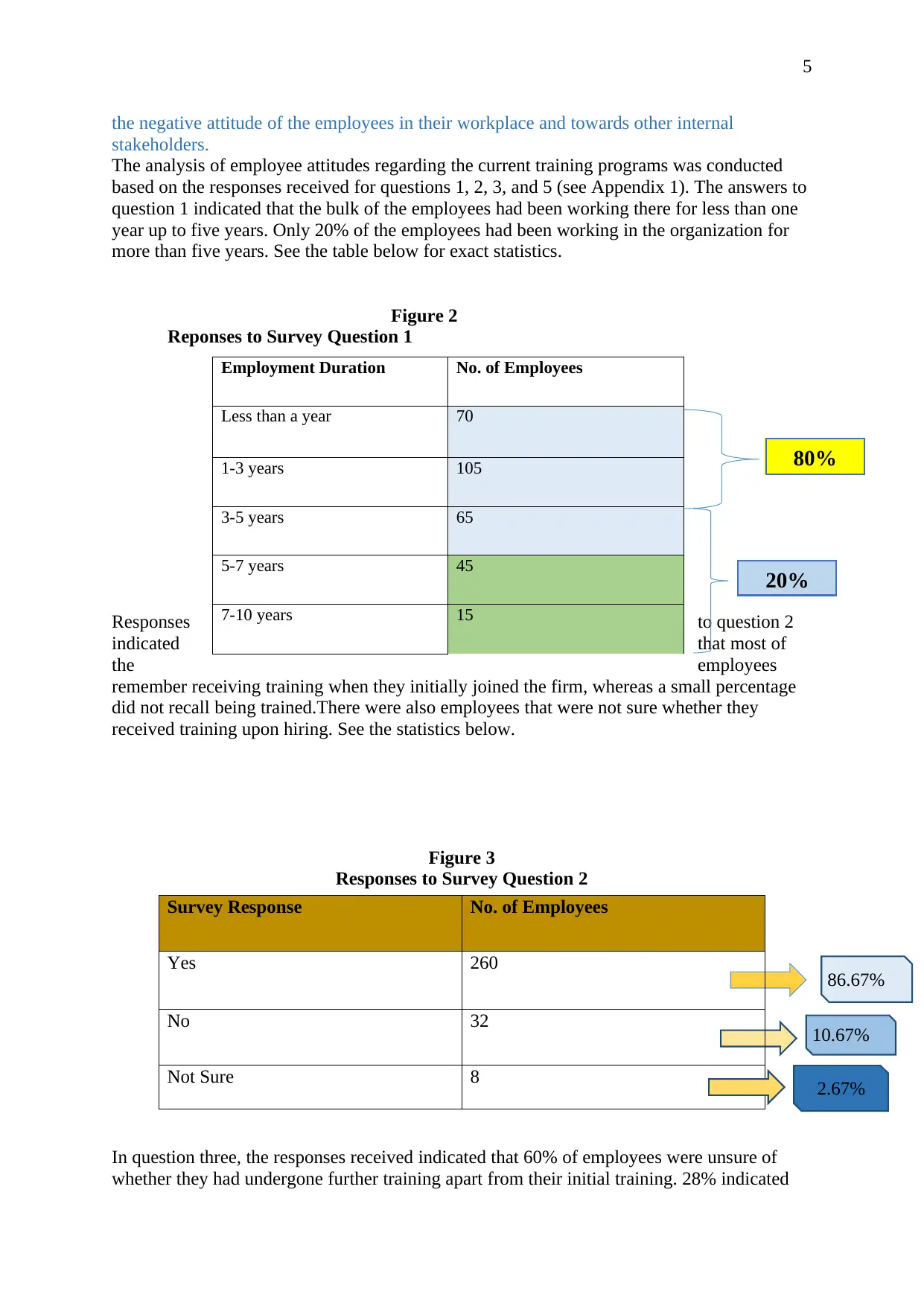
5
the negative attitude of the employees in their workplace and towards other internal
stakeholders.
The analysis of employee attitudes regarding the current training programs was conducted
based on the responses received for questions 1, 2, 3, and 5 (see Appendix 1). The answers to
question 1 indicated that the bulk of the employees had been working there for less than one
year up to five years. Only 20% of the employees had been working in the organization for
more than five years. See the table below for exact statistics.
Figure 2
Reponses to Survey Question 1
Responses to question 2
indicated that most of
the employees
remember receiving training when they initially joined the firm, whereas a small percentage
did not recall being trained.There were also employees that were not sure whether they
received training upon hiring. See the statistics below.
Figure 3
Responses to Survey Question 2
In question three, the responses received indicated that 60% of employees were unsure of
whether they had undergone further training apart from their initial training. 28% indicated
80%
20%
86.67%
2.67%
10.67%
Employment Duration No. of Employees
Less than a year 70
1-3 years 105
3-5 years 65
5-7 years 45
7-10 years 15
Survey Response No. of Employees
Yes 260
No 32
Not Sure 8
the negative attitude of the employees in their workplace and towards other internal
stakeholders.
The analysis of employee attitudes regarding the current training programs was conducted
based on the responses received for questions 1, 2, 3, and 5 (see Appendix 1). The answers to
question 1 indicated that the bulk of the employees had been working there for less than one
year up to five years. Only 20% of the employees had been working in the organization for
more than five years. See the table below for exact statistics.
Figure 2
Reponses to Survey Question 1
Responses to question 2
indicated that most of
the employees
remember receiving training when they initially joined the firm, whereas a small percentage
did not recall being trained.There were also employees that were not sure whether they
received training upon hiring. See the statistics below.
Figure 3
Responses to Survey Question 2
In question three, the responses received indicated that 60% of employees were unsure of
whether they had undergone further training apart from their initial training. 28% indicated
80%
20%
86.67%
2.67%
10.67%
Employment Duration No. of Employees
Less than a year 70
1-3 years 105
3-5 years 65
5-7 years 45
7-10 years 15
Survey Response No. of Employees
Yes 260
No 32
Not Sure 8
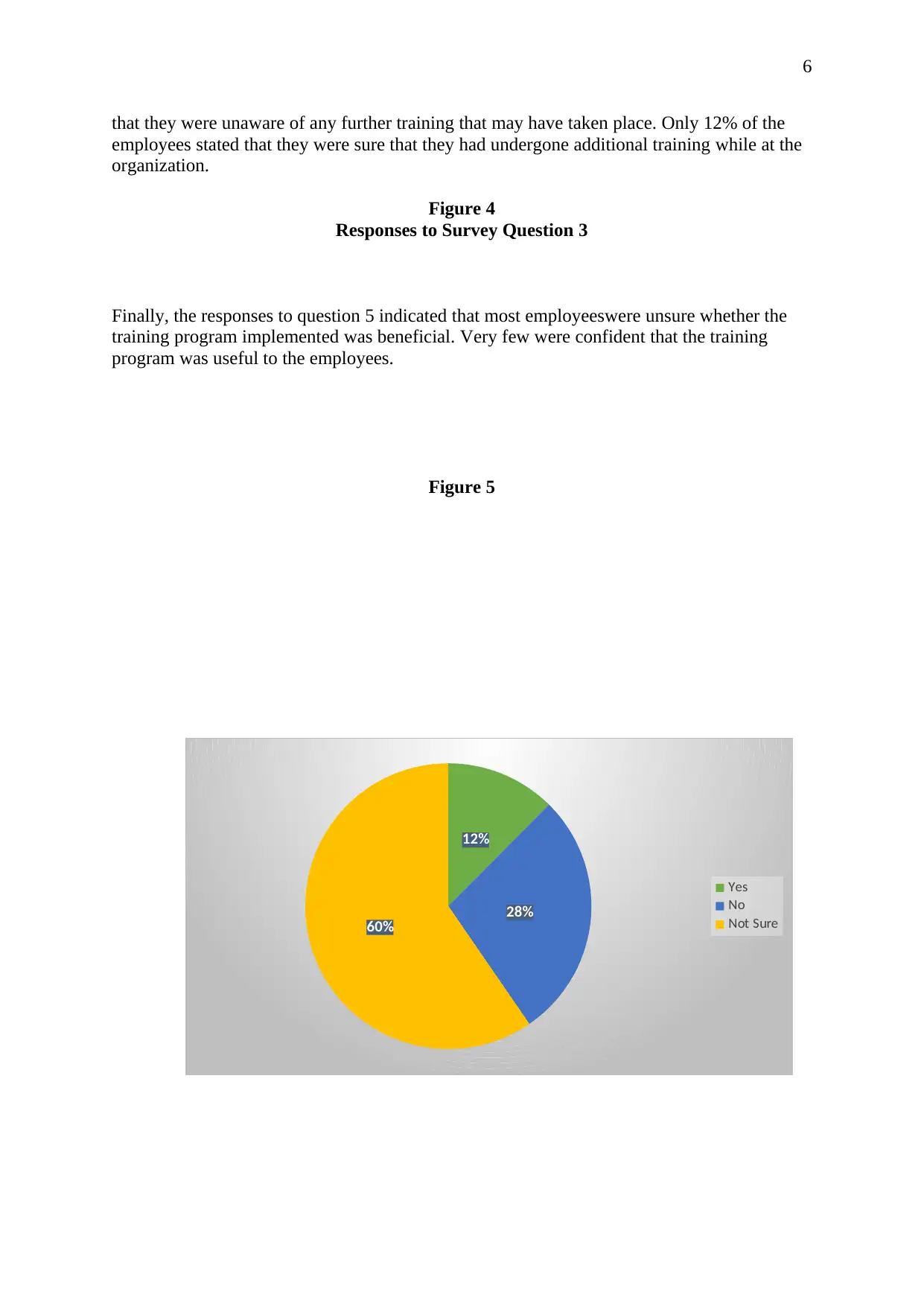
6
that they were unaware of any further training that may have taken place. Only 12% of the
employees stated that they were sure that they had undergone additional training while at the
organization.
Figure 4
Responses to Survey Question 3
Finally, the responses to question 5 indicated that most employeeswere unsure whether the
training program implemented was beneficial. Very few were confident that the training
program was useful to the employees.
Figure 5
12%
28%
60%
Yes
No
Not Sure
that they were unaware of any further training that may have taken place. Only 12% of the
employees stated that they were sure that they had undergone additional training while at the
organization.
Figure 4
Responses to Survey Question 3
Finally, the responses to question 5 indicated that most employeeswere unsure whether the
training program implemented was beneficial. Very few were confident that the training
program was useful to the employees.
Figure 5
12%
28%
60%
Yes
No
Not Sure
⊘ This is a preview!⊘
Do you want full access?
Subscribe today to unlock all pages.

Trusted by 1+ million students worldwide
1 out of 24
Your All-in-One AI-Powered Toolkit for Academic Success.
+13062052269
info@desklib.com
Available 24*7 on WhatsApp / Email
![[object Object]](/_next/static/media/star-bottom.7253800d.svg)
Unlock your academic potential
Copyright © 2020–2025 A2Z Services. All Rights Reserved. Developed and managed by ZUCOL.